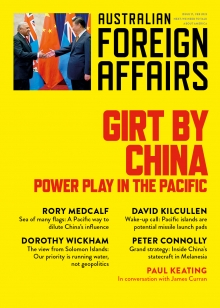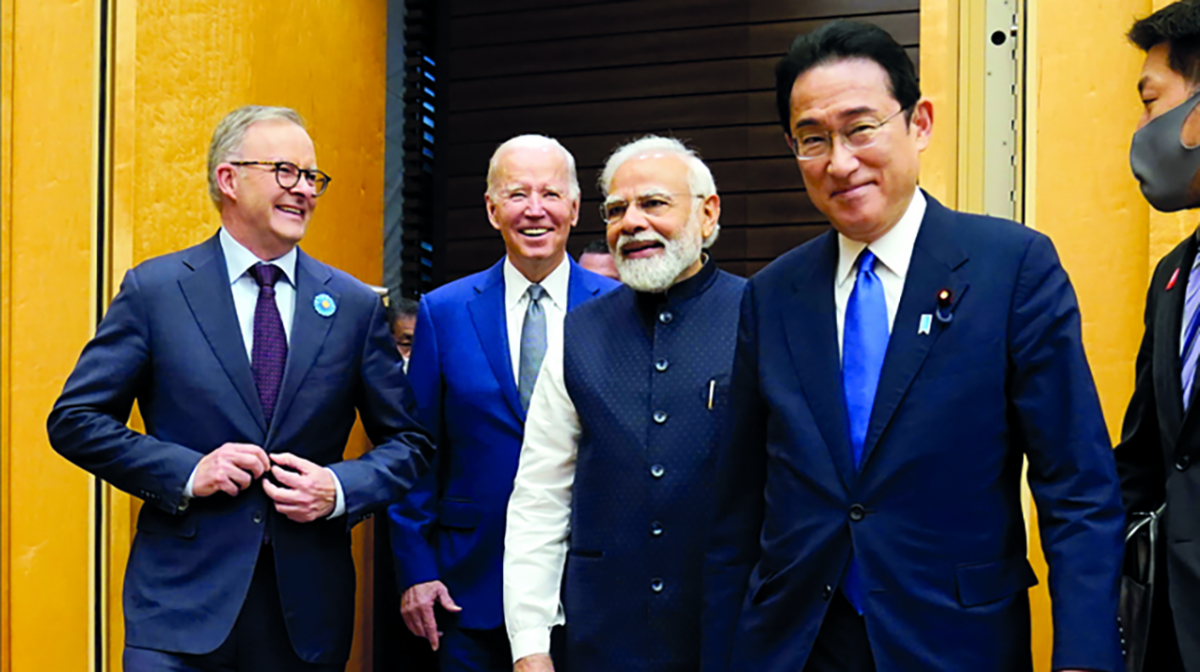
This extract is featured in Australian Foreign Affairs 17: Girt by China.
To read the full issue, log in, subscribe or buy the issue.
Peter Connolly on China’s statecraft in Melanesia
“China is changing the landscape of this country with roads, ports and optic fibre . . . and Fujian grass roots opportunism . . . but when the external financing starts, we will lose control . . . In the next ten years, China will make or break this region.”
—Papua New Guinean entrepreneur, Port Moresby June 2017
For three fascinating weeks in October 2014, I attended the PLA’s 17th International Symposium Course at China’s International College of Defense Studies in Changping, on the northern outskirts of Beijing, as Australia’s representative. The new era was gaining traction as Beijing prepared to host APEC 2014 the following week, and the Belt and Road Initiative (BRI) reached its first anniversary. During the first week, it became clear the external explanation for China’s military strategy was in a state of flux as it began to exceed its “peaceful rise”. Senior Colonel (PLA-AF) Zhou Bo claimed China was being “victimised” by the West’s “containment strategy”. Major General Zhu Chenghu acknowledged there was a “hot debate” on the utility of non-interference, asserting China had “wider interests” and the PLA had “wider duties” than the Second Island Chain.
At this point, retired PLA major general Pan Zhenqiang gave all of us, except the Russian admiral sitting next to me, pause for thought. Pan explained how the West had pushed Russia into a corner with the “notorious policy of containment” depriving it of the “strategic space it needed to survive”. He announced with satisfaction that the “coloured revolution” in Ukraine had given Russia “the golden opportunity to annex Crimea”, drawing parallels to Hong Kong’s “Umbrella Movement”, which had just begun. This was a privileged insight into a Chinese strategic calculus we had not been publicly exposed to. It was a sign of things to come.
Nevertheless, our hosts emphasised China’s adherence to non-interference, and pledged that China would “never have bases overseas”. However, within six months of this performance, the PRC appeared to abandon its careful “peaceful rise” narrative, as the PLA commenced building its first overseas military bases, developed military facilities in the South China Sea and conducted sea trials of its first aircraft carrier. These changes in posture and capability caused speculation about China’s ambitions in the Pacific.
From 2017, the execution of China’s grand strategy became obvious as it enhanced and integrated political, economic and security statecraft in pursuit of influence, resources and access. I witnessed these changes on the ground as I researched China’s interests in Melanesia between 2014 and 2022. After Xi Jinping invited Pacific island countries to “take a ride on the Chinese ‘express train’ of development” in 2014, PRC statecraft coalesced around its efforts to introduce China’s Belt and Road Initiative. As I consulted politicians, officials, academics, business owners, executives, company employees and villagers across China, Timor-Leste, Papua New Guinea, Solomon Islands, Fiji and Vanuatu, I began to understand how China put its statecraft into practice, and how Melanesians responded to it.
The BRI in Melanesia
In the first decade of this century, there was an internal debate in the PRC as it considered abandoning Deng Xiaoping’s 1990 guidance to “keep a low profile”. This resulted in the announcement of PRC president Xi Jinping’s “striving for achievement” in 2013, building on Hu Jintao’s groundwork from 2009 onwards. As early as 2001, Major General Liu Yazhou proposed that China should “go west” into Eurasia and “divide and rule” the islands of South-East Asia and the Pacific. He identified Solomon Islands as a location to “vigorously cultivate pro-China forces”. These ideas have found their place in Xi’s “new era”.
In 2013, Xi initiated the Silk Road Economic Belt and 21st Century Maritime Silk Road, with speeches in Kazakhstan and Jakarta, referring to it as the “One Belt, One Road”, and later as the BRI for international audiences. In March 2015, a strategic road map directed the coordination of China’s interagency resources to support the BRI. It soon became clear the BRI was a strategy, a framework and a narrative for the delivery of China’s grand strategy abroad. The BRI employed economic tools to develop geopolitical influence, and its narrative was attractive to developing countries seeking cheap finance and infrastructure. Within eight years, 145 countries had joined the BRI. In 2017, the Blue Economic Passage officially connected the BRI to the South Pacific.
Senior officials in Papua New Guinean departments and agencies were initially optimistic about possible economic development through the BRI, yet apprehensive about China’s other objectives. The prime minister of Papua New Guinea, Peter O’Neill, had been impressed with the concept during APEC 2014 in Beijing, but there was no BRI corridor to the Pacific. Between April and June 2017, the PRC made a concerted effort to change this. Ambassador Xue Bing and Economic and Commercial Counsellor Liu Linlin were deployed as Beijing’s new representatives in Port Moresby. At the same time, the PRC proclaimed a new route connecting to the South Pacific, and the Ministry of Commerce’s director general for Oceania visited Papua New Guinea. More importantly, Xi was the first world leader to announce he would attend APEC 2018 in Port Moresby.
China’s modern economic statecraft is differentiated by its scale, scope and methods
In June 2018, O’Neill made an official visit to Beijing and became the first Pacific leader to sign a BRI Memorandum of Understanding (MoU), while seeking assistance to hold APEC later that year. Xi invited the leaders of all Pacific island countries that recognised the PRC to a meeting in Port Moresby immediately before APEC, and, by the summit’s end, all the eligible countries had signed MoUs with China for the BRI. Solomon Islands and Kiribati followed in October 2019 after switching recognition from Taipei to Beijing. China had recruited ten Pacific island countries, plus Timor-Leste, to the BRI, which became the conduit for PRC statecraft.
Efforts to integrate China’s grand strategy on the ground in Melanesia have been led by new and more capable staff from its central ministries. China’s diplomatic preparation for the BRI started in 2017, when new staff from the Ministry of Foreign Affairs (MFA) arrived in Timor-Leste, Papua New Guinea and Fiji, and later in Vanuatu and Solomon Islands. This “generational shift” in diplomatic staff was supported by a cohort of higher-quality economic and commercial counsellors from the Ministry of Commerce (MOFCOM). More recently, defence attaché and police adviser positions have been established. These moves enabled the comprehensive employment of PRC statecraft in Melanesia.







